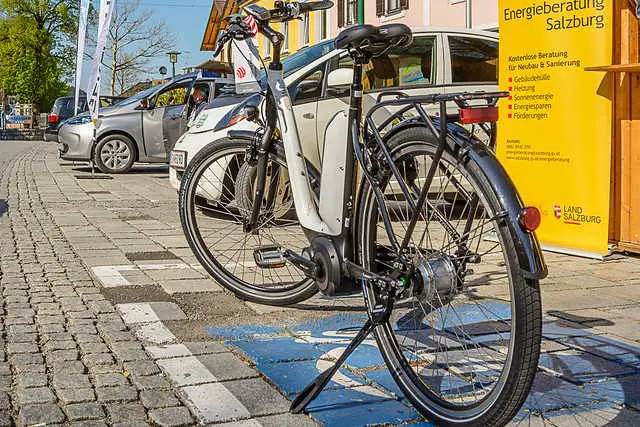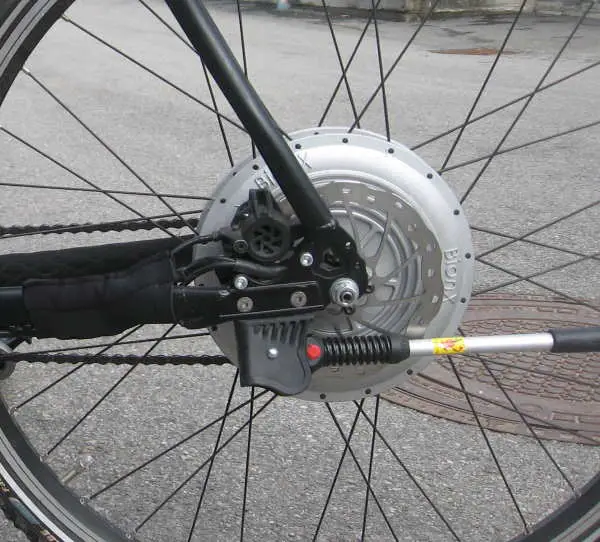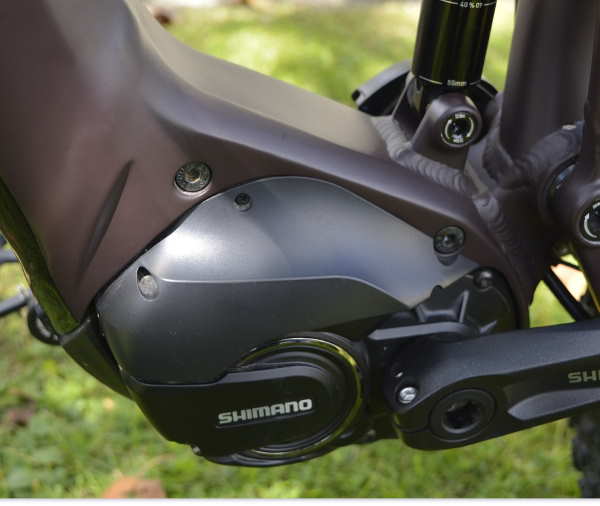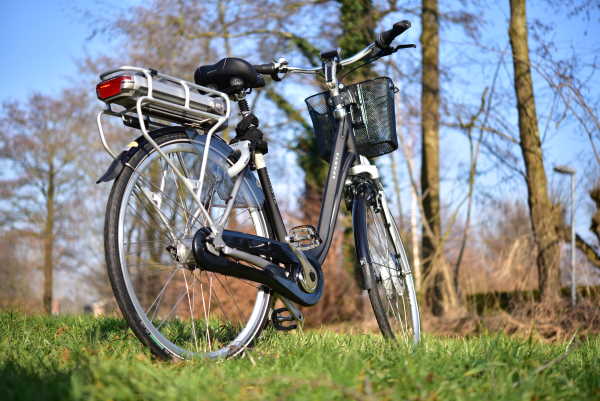Electric bikes are taking the busy city by storm. E-bikes are the almost perfect combination of speed, cost and convenience to escape the congestion on your trip to work. Read on as we explore everything you need to know before buying an e-bike.
Electric bike summary
- Range is the wrong comparison tool to use when comparing electric bikes
- Know the simple math tip to compare battery capacities easily
- Think carefully before buying an e-bike with a proprietary styled battery pack
- Use some simple battery care tips to get the most out of your investment
- Know if there are any legal limits on the maximum power rating of your electric bike motor in your State or Country
- Check the componentry, look for a quality brand name on the components (Bosch for example) rather than generic or re-badged components.
- Know how you intend using your electric bike before hitting the shops. An e-bike for commuting, touring, mountain biking have quite different needs.
- Decide on Hub Drive Motor or Mid Drive Motor
Why buy an electric bike for commuting?
Electric bikes have a lot going for them for a city commute. Cycling can be the most efficient and pleasurable way through city congestion. An electric bike can extend the comfortably commutable range you can manage. E-bikes also open up the opportunity of cycling to work for anyone who is new to cycling or hasn’t cycled for a long time, effectivly supporting the cyclist as thier finess improves.
Cost Saving
Though electric bikes are a reasonably large upfront cost, they require no licence or registration costs. Compared to gas (petrol), electric bikes are incredibly cheap to run.
Another significant saving is in parking costs. City parking is generally premium priced. Where a parking space is part of an employment or salary perk, see if you can sacrifice the allocated parking for some extra dollars in your pocket.
As cities move towards reducing the increase in congestion, they have introduced congestion charging, increased parking costs. An electric bike can help you financially avoid these charges.

Parking
Speaking of parking, the ability to park directly outside or (preferably) within your place of work reduces commuting hassle and stress significantly.
Popping into the coffee shop on the way to work by parking right at the door is a real time-saver too.
Avoid congestion
The distinct advantage here is your electric bike can offer the freedom to navigate around or through congestion. In many major cities, electric bikes are a more time-efficient way of getting from A to B than a car.
Health and fitness
One of the most exciting possibilities with electric bikes is that they open (or re-open) the benefits of cycling. Hilly commutes are no longer a barrier. Current fitness level is also no longer a barrier; the use of an electric bike can bring massive health improvements to anyone who was previously inactive.
Electric bikes bring the same health and fitness benefits from traditional cycling to a much wider range of people and demographics. It’s encouraging to see the adoption of e-bikes in both the young and old. Our local city has at least two cycling communities comprised mostly of retired cyclists moving around the city and coffee shop on their e-bikes.
How does an e-bike work?
Electric bikes comprise of a powerful battery pack, a wheel or mid-mounted motor and electronic monitoring and display components. Power is provided to the motor to either assist the rider or via a throttle to power the wheel unassisted. The assisted mode is the most commonly used mode and provides the best combination of range and power.
Types of electric bike systems
Pedal Assist System (PAS) and Torque assist. PAS is more commonly used. PAS uses a disk in alignment to the front crank (where the pedals attach). On the disk are a number of small magnets. When these magnets pass a sensor, the system knows you are pedalling and provides additional assistance. The speed at which the magnets pass the sensor indicates to the system how quickly you are pedalling.
A Torque sensing system typically uses a sensor (a spring) in the bottom crank to determine how much pressure you are placing on the crank (via the pedals). The system then provides assistance.
PAS are more common, simpler, and we believe it provides a more natural feeling ride.
Motor Types in electric bikes
There are three typical motor types in use on electric bikes. Of the three, none are ‘best’. Each has its own characteristics.
Geared Hub Motor
This type of motor is fitted in the centre of the rear wheel. Compared to a direct-drive hub (below), geared-hub motors are smaller. They have internal gearing to allow say 4 rotations of the motor equate to 1 rotation of the wheel.
A significant advantage is that these motors are fitted with bearings to allow for a true free-wheel. This reduces friction when free-wheeling downhill or when riding the bike without any assistance.

Direct Drive Motor Hub
Again the direct drive motor hub fits directly to the rear wheel of the bike. Direct drive has no gearing, and they are larger and often heavier.
Though technically simpler than a geared-hub drive this doesn’t seem to result in increased life or reliability. A direct-drive hub limits gear selection and top speed.
Hub-drive motors
Irrespective of being geared or un-geared. Hub-drive motors are cheaper to fit into the overall design of an e-bike. In terms of bang-for-buck hub-drive motors win out. As hub-drive bikes don’t require costly custom bottom-bracket design, smart purchasing can get you higher-end frame, and other componentry for less than the cost of a mid-drive motor.
Hub-drive motors can take a little adjustment as they give a sensation of being ‘pushed-along’ similar to being on a Scooter of small motorbike. A significant advantage is that hub-drive motors can be used to propel you via the throttle with no input from you in pedalling.
Wheel replacement or repairing a puncture on your commute is a little more complex depending on the hub design. The wheel itself is heavier due to the hub-motor. Making sure you align the wheel correctly when re-installing is essential. Have the bike-shop run you through a wheel change on your e-bike before leaving the store.
For a commuter e-bike hub-drive would be out choice.
Mid-Drive Motor Hub
Mid Drive Motor hubs attach to the front crank (near where you pedal). The assisted power is applied to the front crank. Mid-drive hubs rely on the bike chain or belt to power the rear wheel.

Technically Mid-Drive can wear down bike chains, front cranks and derailleurs faster than normal. However, if you maintain the drive chain regularly, which we know we should with any commuting bike, this effect is pretty minimal.
Mid-drive motors are unkind of chains, we’ve had a few chain breaks when the system is under strain. Chain stretching is also increased with mid-drive motors. A stretched chain doesn’t line up correctly with the teeth in the gears causing wear.
‘Shark Teeth’ teeth on the front or rear cogs are a deal-breaker if looking at a used e-bike. At the point of having that amount of wear, new cranks and derailleurs are needed, none of which are cheap to replace and a sign the bike is poorly maintained.
Mid-drive motor hubs often provide the cyclist with full control over gear selection. You can pull a wheelie or achieve a high top-speed with a Mid-Drive hub. These hubs are more natural feeling to ride.
Mid-drive hubs tend to be more expensive, partly because the bike frame requires a customised design around the bottom bracket. when mid-drive motors first came into production bikes this higher cost was very apparent. While the cost difference between mid-drive and hub-drive isn’t as great now, it is still a consideration. Buying a hub-drive bike with better overall componentry rather than a mid-drive bike with lessor componentry can be an unwise move.
What is the maximum range of an electric bike?
Range is an incredibly un-reliable metric to use to compare e-bikes. Manufacturers and advertisers often make some incredibly bold claims on the maximum range.
Hills, the level of pedal assist, head-wind, tail-wind and type of terrain all make a significant impact on the range of an e-bike.
Typically with pedal-assist expect 20-40 miles range, usually towards the 20-25 mile range. Obviously, the more you leave the motor to do the hard work, the less range you will get.
To compare the likely ranges of specific bikes, a reasonable approach is to divide Watt-hours by 20. Read further down this article if the specification sheet on the bike you are eying-up doesn’t state watt-hours.
Example range ‘guestimate’
240 Watt-hours
240 / 20 is 12. So our guestimate would be 12 miles.
Electric bike batteries important points
Again, know the underlying components. If in doubt, ask. Depending on your level of trust with where you are buying your electric bike, don’t be afraid to ask to ‘prove’. A local bike store should have access to a detailed component list that will specify cell type in the battery pack.
Panasonic, LG, Samsung batteries are well respected and proven brands. These brands also largely stand by their products and reputation. Cells are more standard and cheaper to source and replace.
Samsung batteries appear to have the edge currently in the electric bike community.
This leads us to an important topic. Many high-end electric bikes have custom designed battery packs that elegantly fit into the bike design. Some have bike framing/tubing to incorporate a highly customised battery pack.
Custom battery packs are less likely to be found in mid or low range electric bikes. But do check!
Despite the elegant design and eyecatching symmetry or customised battery packs, we believe the disadvantages of these systems outweigh the apparent beauty.
It’s not uncommon to find that a highly customised battery pack can only be replaced by purchasing through the bike manufacturer. We’ve seen $1200+ quotes for battery replacement.
Obeslecense is also a big consideration. We have traditional bikes well over 10-15 years old that are in regular use. To keep these bikes on the road, components have been swapped out over their lifetime. Thankfully with standard (largely Shimano) components, we’ve always been able to repair these bikes with off-the-shelf replacement components or upgrades.
This might not be an option if your bike manufacturer stops making the battery pack. Even if the battery cells are standard, a highly proprietry casing can be expensive to replace if its damaged by a fall or poor storage. As electric bike technology is rapidly advancing, we expect some manufacturers will abandon maintaining some of the older model parts.
Top Tip: Stick with standard battery pack designs. These can be more cheaply replaced. The cells inside are often 18650 Lithium-Ion (Li-Ion) cells, 18650 cells are easily available and widely used for many purposes. As long as you can open the battery pack, you or your bike shop can easily replace cells cost-effectively.
A non-proprietary battery pack also opens up the opportunity for quality OEM type replacement parts.
Avoid generic, or unbranded batteries. Other battery technologies to avoid on your e-bike purchase are NiMH and Lead Acid.
How do I compare electric bike battery capacity?
Manufacturers and e-bike brochures use different measurements of the battery capacity of their electric bikes. The lack of consistency can make it tricky to make a like-for-like comparison. Within reason, you want the most battery for your dollar.
Often the manufacturer is playing to their strengths. Thankfully it is easy to bring the claimed numbers into something comparable.
The most significant figure in battery capacity for a given e-bike is amp-hours or AH. A little math can make it easy to compare any battery.
Volts x Amp Hours = Watt Hours
A couple of examples
24 Volts, 10 ah
24 x 10 = 240 watt-hours
48 Volts, 10 ah
48 x 10 = 480 watt-hours
We can also work with what we know to fill in the blanks. For example:
480-watt hours, 48 Volts
480 / 48 = 20 ah
or
240-watt hours, 10 ah
240 / 10 = 24 Volts
The tip here is to work with one value such as watt-hours when comparing batteries from different bikes.

How long do electric bike batteries last?
Electric bike batteries lose charge when they are stored. After around 3 months, they will have lost a significant amount of charged storage. Regular charging is a good approach to battery longevity.
If you are storing your bike for a long period of time, an optimal charge level is 60-80% charged before storing. It’s important to never store your e-bike for a long time when the battery is ‘flat’. The charge can drop below the amount required to keep the cells active and able to receive a future charge.
The life of an electric bike battery is typically in the 1000 recharge cycle range. This refers to 1000 full discharge-recharge cycles. So a quick recharge of 10% would need to be done 10 times to count as a charge cycle.
Typically expect a battery to last 3-5 years before replacement.
Again we recommend avoiding proprietary battery designs. Your battery will require replacement at some point. A quality bike with a reasonable amount of regular maintenance should outlive many battery pack replacements.
How to look after my electric bike battery
Good e-bike batteries should be Lithium-Ion (Li-Ion) batteries. As we mentioned earlier, these batteries are generally good for 1000 recharge cycles. However, you can unwittingly reduce the health and lifespan of your batteries if not careful.
Li-Ion batteries thrive at room temperature. High temperature is damaging to the battery cells.
High or over-charging. Avoid the temptation to leave your batteries on charge all weekend ready for Monday’s commute. Typically electric bike batteries fully charge in 4-7 hours. Consider charging your battery to around 80-90% charge rather than ‘filling it up’ each time.
Hot temperature and fully charged cells are the worst enemies of your battery pack. This combination can drastically reduce the lifespan of your battery pack.
Depending on your climate, consider where you park and store your bike. A cooler place out of direct sunlight is ideal. Many battery packs are in black casings which further absorbs heat, compounding any effect of being left in sunlight for hours each day.
Is a more powerful electric motor better on my e-bike?
More is better right? Well not necessarily. A 250-watt electric bike has a great combination of lightness and enough power to assist you around town. A 250 watt would struggle to hill-climb without input from you through the pedals. 500-watt would readily take on those hills without any pedal input from you and propel you at a good speed on the flat.
750-watt would take on all but the steepest of hills without you having to provide any power to the pedal.
Many States and Countries have legal limits on the maximum output permitted for a bicycle to remain classified as a bicycle. Be sure to check before purchase.
300-watt to 500-watt is an excellent sweet spot for commuting. The motor will be largely un-strained on a typical ride helping increase reliability. This is also a good mid-point for price and weight.
How long does an e-bike battery take to recharge?
Most electric bike batteries take between 4-7 hours to charge fully. There is no need to discharge your battery before recharging it fully. Regular, partial, recharges are a good strategy for Li-Ion batteries. So an opportunistic quick recharge at work or home is a great idea.
Top Tip: Leaving your bike battery on charge for a long period of time isn’t good for the battery cells, reducing the lifespan of your (expensive) battery pack.
Do I need regenerative braking on my electric bike?
A number of electric bikes promote regenerative braking as a selling point. The claim is that when you are braking the kinetic energy is converted to electricity rather than heat.
If we obsess a little too much over the maximum range (read above), its a compelling argument. A free recharge every time you brake or coast downhill. Typically electric bikes featuring regenerative braking are significantly more expensive than those without.
If a manufacturer states a typical range extension from using regenerative braking, it is generally in the 10% range. Real-world feedback is that a return of around 4% is more typical reported.
There is also some concern and feedback that the regenerative recharge system adds wear and tear on the battery. As the batteries are typically one of the most costly components to replace, that is worth considering.
Regenerative braking has the potential to reduce wear and tear on your disk braking system, hydraulics and brake pads. Compared to the replacement costs of a motor or battery we’d rather replace disks and pads slightly more often than be hit in the wallet for a motor or battery replacement.
From the real-world range, added complexity and potential battery wear perspective, we’d usually recommend avoiding a regenerative braking system. Though if the bike you have your heart and wallet set on happens to have regenerative braking, that is great too.
If you are keen to extend bike range, look towards battery improvements.
Which e-bike motor is best?
Be wary of claims of specific motors being ‘better’ or more performant than others. Within a specific Watts rating, reliability and longevity are much more important than a ‘claimed’ 5% efficiency improvement.
Look for componentry from big established brands, Bosch is particularly well known for electric motors.
Avoid generically branded motors, ask for a spec sheet from your bike shop or retailer. Many imported bikes use flash-looking motors that have a short lifespan and can be difficult to source a replacement or repair for.
Generally, any claims that ‘my’ 350-watt motor out-performs the competitions 350-watt motor are, to be polite, junk claims. Quality electric motor manufacturers promote reliability, strength and are likely to back their product with a meaningful warranty/guarantee.